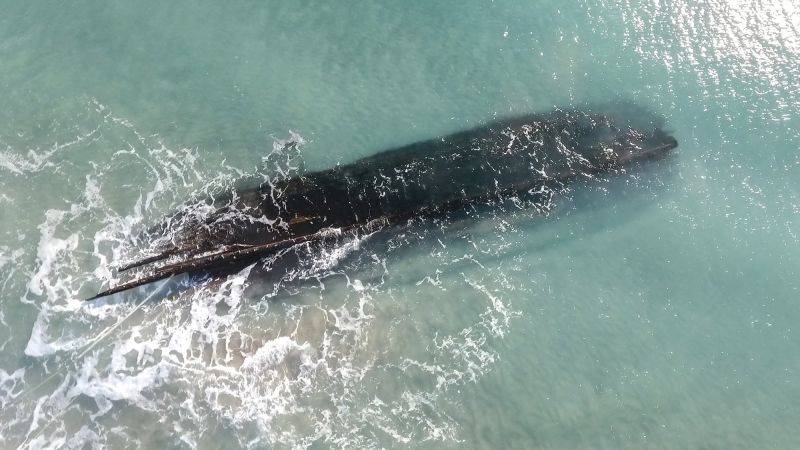A mysterious shipwreck suddenly appeared on the shores of a Newfoundland coastal community last month, believed to have been dislodged from the seabed by a fierce storm. Now, as a new storm barrels toward eastern Canada, the community is in a race against time to save it.
The wreck, lodged in shallow waters near the small town of Cape Ray, was discovered by a local resident on the morning of January 20.
As soon as Shawn Bath and Trevor Croft, both from the Clean Harbours Initiative, heard about it, they grabbed their dive gear and rushed down to the beach. Swimming around the vessel, they attempted to secure it by slinging ropes across its 100-foot-long frame.
Both men have been working in the region for two years as part of a coastal clean-up operation in the wake of Hurricane Fiona, which slammed into Canada’s Atlantic Coast in 2022 as one of the most powerful storms in the country’s history.
Bath believes it was Hurricane Fiona that initially dislodged the shipwreck from its resting place, before it slowly drifted toward the southwestern coastline of Newfoundland island, pushed along by storms and sea swells.
Now, as a new storm approaches, the community is scrambling to stop the vessel being destroyed by the same elements that brought it to their shores.
The Cape Ray shipwreck is an example of a wider phenomenon, experts say, where climate change-fueled storms are uncovering the world’s underwater history — but also destroying it.
The wreck’s origins and age remain unknown. Croft said it may be a French or British ship possibly around 200 years old, but until it comes out of the water, it’s all guesswork, he said.
Lisa Briggs, an underwater archaeologist and research fellow at Cranfield University in the UK, said the wreck is significant for the community because it could be a clue as to how people arrived on the island.
But this preserved slice of local history is at risk. The tides are already weakening the vessel. While the wood is in good shape, it is held together with copper and brass pins. “Every time the wave goes underneath that ship and raises it up a little bit, those beams get looser and looser,” Bath said.
The approaching storm, forecast to arrive Wednesday evening, has raised the stakes even further. Forecasts suggest wind gusts of 25 mph around Cape Ray with waves up to 20 feet.
“The wreck could just pretty much disintegrate,” Croft said.
Without government funds to extract and preserve the wreck, Bath and Croft are trying to raise funds through a GoFundMe campaign. Their aim is to pull the wreck from the water to preserve it and, ultimately, put it on display as a tourist attraction for this remote community.
“It’s a race against time,” Croft said.
The phenomenon of storms dislodging shipwrecks from seabeds — where they have sometimes rested for centuries — is not uncommon, Briggs said, especially as climate change fuels more powerful and more intense storms.
While that might sound like a good thing for underwater archaeologists, it often isn’t, she added. When storms rip the protective layers of sand off shipwrecks, they can cause irretrievable damage. “It’s much better if the archaeologists themselves are gently removing sand in a controlled way,” Briggs said.
Climate change presents other threats to shipwrecks, too, Briggs added.
Rising levels of carbon pollution in the atmosphere are changing the chemistry of seawater, making it more acidic. This can accelerate the disintegration of delicate, organic materials preserved on wrecks, such as ropes, sails and textiles.
Then there’s the underwater archeologist’s nightmare: shipworms. These worm-shaped mollusks have a voracious appetite for wood.
Shipworms have traditionally only been found in warmer waters, meaning wrecks in the colder waters were considered safe from their destruction. But as the oceans warm, the mollusks are migrating further north. In 2016, archaeologists hauled up a piece of wood from the Arctic seafloor teeming with slimy, white shipworms.
“The more we see climate change affecting our world today, the more damage we’re going to see to submerged cultural heritage,” Briggs said.
It matters, she said, because ships tell a unique story about our past. “You have this one moment in time, that’s been perfectly crystallized on the seafloor,” she said.
In Cape Ray, Croft and Bath are doing all they can to protect the mysterious wreck.
Bath can’t quite believe how much of a challenge it has been. “Something so beautiful drifts ashore in this little town,” he said, “and we’re struggling to get finances to haul it out of the water before the storms destroy it.”






































